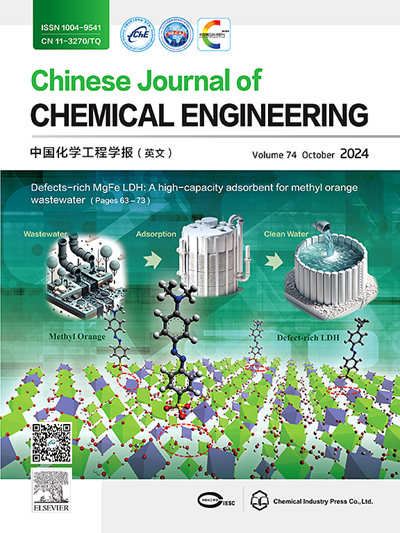Micellization behavior and thermodynamic properties of cetyltrimethylammonium bromide in lithium chloride, potassium chloride, magnesium chloride and calcium chloride solutions
IF 3.7
3区 工程技术
Q2 ENGINEERING, CHEMICAL
引用次数: 0
Abstract
The micellization behavior and thermodynamic properties of cetyltrimethylammonium bromide (CTAB) in single lithium chloride (LiCl), potassium chloride (KCl), magnesium chloride (MgCl2) and calcium chloride (CaCl2) solutions were investigated at 288.15−318.15 K. Result showed that the critical micelle concentration (CMC) values of CTAB in all solutions decreased to a minimum value around 298.15 K and then increased with further increasing the temperature. In all cases, the CMC values decreased with increasing salt concentration at each temperature. Additionally, the introduction of any single salt resulted in a reduction of CMC values for CTAB, attributed to the combined effects of counterions and entropy-driven interactions. The observed trend for CMC values was as follows: > > > . Furthermore, standard thermodynamic parameters, including standard free energy of micellization (), standard enthalpy of micellization () and standard entropy of micellization (), were calculated based on the obtained CMC values. The negative values of indicated that the formation of CTAB micelles was a spontaneous behavior. The variations in and suggested that micellization was primarily entropy-driven at temperatures between 288.15 and 298.15 K, while it was influenced by both entropy and enthalpy from 298.15 to 318.15 K. Fourier transform infrared spectroscopy (FTIR) and transmission electron microscope (TEM) were employed to further explore the effects of salts on the micellization behavior of CTAB.

十六烷基三甲基溴化铵在氯化锂、氯化钾、氯化镁和氯化钙溶液中的胶束行为和热力学性质
在288.15 ~ 318.15 K的温度下,研究了十六烷基三甲基溴化铵(CTAB)在单一氯化锂(LiCl)、氯化钾(KCl)、氯化镁(MgCl2)和氯化钙(CaCl2)溶液中的胶束行为和热力学性质。结果表明,CTAB在所有溶液中的临界胶束浓度(CMC)值在298.15 K左右减小到最小值,然后随着温度的进一步升高而增大。在所有情况下,CMC值随盐浓度的增加而降低。此外,由于反离子和熵驱动相互作用的共同作用,任何单一盐的引入都会导致CTAB的CMC值降低。CMC值的观测趋势如下:CMCKCl祝辞CMCLiCl祝辞CMCCaCl2> CMCMgCl2。根据得到的CMC值,计算了胶束自由能(ΔGm0)、胶束焓(ΔHm0)和胶束熵(ΔSm0)等标准热力学参数。ΔGm0的负值表明CTAB胶束的形成是自发的行为。ΔHm0和ΔSm0的变化表明,在288.15 ~ 298.15 K之间胶束化主要受熵驱动,而在298.15 ~ 318.15 K之间胶束化同时受熵和焓的影响。采用傅里叶变换红外光谱(FTIR)和透射电子显微镜(TEM)进一步研究了盐对CTAB胶束化行为的影响。
本文章由计算机程序翻译,如有差异,请以英文原文为准。
求助全文
约1分钟内获得全文
求助全文
来源期刊

Chinese Journal of Chemical Engineering
工程技术-工程:化工
CiteScore
6.60
自引率
5.30%
发文量
4309
审稿时长
31 days
期刊介绍:
The Chinese Journal of Chemical Engineering (Monthly, started in 1982) is the official journal of the Chemical Industry and Engineering Society of China and published by the Chemical Industry Press Co. Ltd. The aim of the journal is to develop the international exchange of scientific and technical information in the field of chemical engineering. It publishes original research papers that cover the major advancements and achievements in chemical engineering in China as well as some articles from overseas contributors.
The topics of journal include chemical engineering, chemical technology, biochemical engineering, energy and environmental engineering and other relevant fields. Papers are published on the basis of their relevance to theoretical research, practical application or potential uses in the industry as Research Papers, Communications, Reviews and Perspectives. Prominent domestic and overseas chemical experts and scholars have been invited to form an International Advisory Board and the Editorial Committee. It enjoys recognition among Chinese academia and industry as a reliable source of information of what is going on in chemical engineering research, both domestic and abroad.
 求助内容:
求助内容: 应助结果提醒方式:
应助结果提醒方式:


